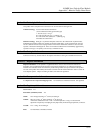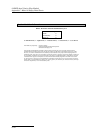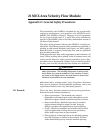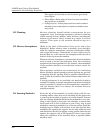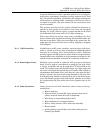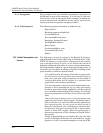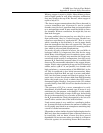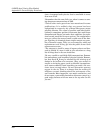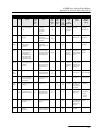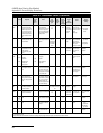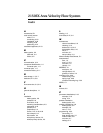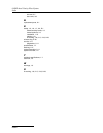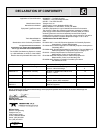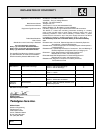
2150EX Area Velocity Flow Module
Appendix D General Safety Procedures
D-7
Table D-1 Hazardous Gases
Gas Chemical
Formula
Common
Properties
Specific
Gravity or
Vapor
Density
Air = 1
Physiological
Effect*
Max
Safe
60 Min.
Exposure
ppm
Max.
Safe
8 Hour
Exposure
ppm
Explosive
Range
(% by vol.
in air.)
Limits
lower/upper
Likely
Location
of
Highest
Concentration
Most
Common
Sources
Simplest and
Cheapest
Safe Method
of Testing
Ammonia NH
3
Irritant and poisonous. Col-
orless with characteristic
odor.
0.60 Causes throat and
eye irritation at
0.05%, coughing
at 0.17%. Short
exposure at 0.5%
to 1% fatal.
300
to
500
85 16
25
Near top.
Concentrates
in closed up-
per spaces
Sewers, chemical
feed rooms
Detectable
odor at low
concentrations
Benzene C
6
H
6
Irritant, colorless
anesthetic
2.77 Slight symptoms
after several hours
exposure at 0.16% to 0.32%.
2% rapidly fatal.
3,000
to
5,000
25 1.3
7.1
At bottom Industrial wastes,
varnish, solvents
Combustible
gas indicator
Carbon
Bisulfide
CS
2
Nearly odorless
when pure, color-
less, anesthetic.
Poisonous.
2.64 Very poisonous,
irritating, vomiting,
convulsions, psychic distur-
bance.
—151.3
44.0
At bottom An insecticide Combustible
gas indicator
Carbon
Dioxide
CO
2
Asphyxiant, Colorless,
odorless. When breathed
in large quantities, may
cause acid taste.
Non-flammable. Not gen-
erally present in danger-
ous amounts unless an
oxygen deficiency exists.
1.53 Cannot be endured at 10%
more than a few minutes,
even if subject is at rest and
oxygen content is normal.
Acts on respiratory nerves.
40,000
to
60,000
5,000 —
—
At bottom;
when heated
may stratify
at points
above bottom.
Products of combus-
tion, sewer gas,
sludge. Also issues
from carbonaceous
strata.
Oxygen
deficiency
indicator
Carbon
Monoxide
CO Chemical asphyxiant. Col-
orless, odorless, tasteless.
Flammable.
Poisonous.
0.97 Combines with hemoglobin
of blood. Unconsciousness
in 30 min. at 0.2% to 0.25%.
Fatal in 4 hours at 0.1%.
Headache in few hours at
0.02%.
400 50 12.5
74.0
Near top,
especially if
present with
illuminating
gas.
Manufactured gas,
flue gas, products of
combustion, motor
exhausts. Fires of
almost any kind.
CO ampoules
Carbon
Tet ra -
Chloride
CCl
4
Heavy, ethereal odor. 5.3 Intestinal upset, loss of con-
sciousness, possible renal
damage, respiratory failure.
1,000
to
1,500
100 —
—
At bottom. Industrial wastes,
solvent, cleaning
Detectable odor
at low concentrations
Chlorine Cl
2
Irritant. Yellow-green color.
Choking odor detectable in
very low concentrations.
Non-flammable.
2.49 Irritates respiratory tract.
Kills most animals in a very
short time at 0.1%.
41—
—
At bottom. Chlorine cylinder and
feed line leaks
Detectable odor at
low concentrations
Formal-
dehyde
CH
2
O Colorless, pungent suffo-
cating odor.
1.07 Irritating to the nose. — 10 7.0
73.0
Near bottom Incomplete combus-
tion of organics.
Common air pollut-
ant, fungicide.
Detectable odor
Gasoline C
5
H
12
to
C
9
H
20
Volatile solvent.
Colorless. Odor notice-
able at 0.03%. Flammable.
3.0
to
4.0
Anesthetic effects when
inhaled. Rapidly fatal at
2.4%. Dangerous for short
exposure at 1.1 to 2.2%.
4,000
to
7,000
1,000 1.3
6.0
At bottom Service stations,
garages, storage
tanks, houses.
1. Combustible
gas indicator.
2. Oxygen
deficiency
indicator.**
Hydrogen H
2
Simple asphyxiant. Color-
less, odorless, tasteless.
Flammable
0.07 Acts mechanically to deprive
tissues of oxygen. Does not
support life.
——4.0
74.0
At top Manufactured gas,
sludge digestion tank
gas, electrolysis of
water. Rarely from
rock strata.
Combustible gas
indicator
Hydrogen
Cyanide
HCN Faint odor of bitter
almonds.
Colorless gas
0.93 Slight symptoms appear
upon exposure to 0.002% to
0.004%. 0.3% rapidly fatal.
—106.0
40.0
Near top Insecticide and
rodenticide
Detector tube



